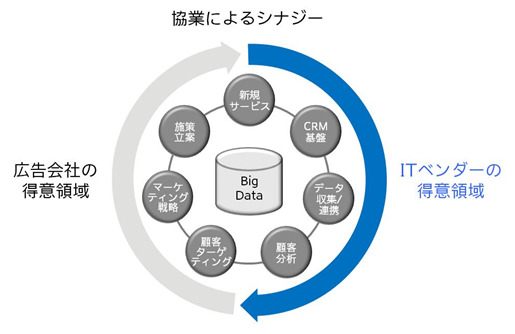Did you notice how frequently articles about collaborations between advertising agencies and IT vendors in the big data field graced the front pages of business newspapers last year? Dentsu Inc. also announced a business partnership with Fujitsu Limited (hereinafter Fujitsu) in May of last year (※1).
This time, we focus on why advertising agencies and IT vendors—whose cultures and practices seem almost polar opposites—are collaborating, what is happening as a result of this collaboration, and future prospects.
The Purpose of Advertising Agency-IT Vendor Collaboration
Gartner has stated, "By 2017, the CMO (marketing department) will invest more in IT than the CIO (information systems department)." For advertising agencies, building the capability to provide comprehensive marketing solutions for clients' IT investments in the marketing domain is now an urgent priority.
As core enterprise systems, front-end systems (e-commerce, customer management, sales management, etc.), and sales channels serving as user interfaces (websites, SNS, surveys, stores, etc.) increasingly integrate and consolidate internal and external information, the definition of "marketing" is shifting. Previously focused on sales strategy and promotions, it is now evolving toward designing and maximizing the efficiency of the entire corporate supply chain.
Within corporate supply chains, core and front-end systems are often managed by the IT department, while sales strategy and promotions fall under the marketing department. Seamless marketing activities require collaboration between both departments, yet effective coordination often proves challenging. In this context, a framework where IT vendors supporting the IT department and advertising agencies supporting the marketing department jointly assist the company represents a significant step forward in driving integrated information utilization.

What Has Happened Since Collaboration Began
Over half a year has passed since Fujitsu and our company began our collaborative activities. We have undertaken numerous initiatives, primarily in the retail, automotive, and entertainment industries. I would like to share the key insights gained through these efforts.
[1] A Common Language is Essential
We increasingly collaborate with corporate information systems departments on projects like building sales management platforms.
A key difference in our respective practices is the development process and deliverables. For example, the campaign-based systems advertising agencies typically handle and the long-term core systems used by corporations have fundamentally different approaches. This necessitates creating a common language between us. While this remains a time-consuming challenge with many hurdles, we are progressing with the cooperation of IT vendors and corporate marketing departments.
【2】Differences in Data Type and Volume
The big data handled by IT vendors is massive, comprehensive data sets about things—like appliance log data, energy data, vehicle driving data, and ID-POS data. This differs significantly in both type and volume from the data advertising agencies have traditionally dealt with. Being able to consider this data—which only IT vendors with massive system resources can handle—for marketing improvement and new business development has broadened the scope and perspective of our activities as an advertising agency.
【3】Marketing Using Sensor-Based Technologies
The sensor technologies owned by IT vendors can measure a surprisingly wide range of human states and movements, enabling their use in surveys and observations to reveal customers' latent consciousness and behaviors. Furthermore, as mentioned previously, they can be utilized as customer management solutions to maximize customer experience value. Here too, I believe our scope of activities and perspective have broadened.

Creating an environment where data can be leveraged to better motivate customers
What will emerge from the collaboration between advertising agencies and IT vendors going forward?
Personally, I believe one key development will be the advancement of building a "(Private) DMP" (※2) that extends the scope of information integration beyond the company and connects with external data. The future outlook involves jointly creating an environment where a company's big data can be leveraged as actionable customer data. This is achieved by integrating the company's owned real-world data with external digital data, and further linking this with advertising delivery platforms like "DSP" (※3) and information delivery mechanisms to smart devices, such as "O2O".
Beyond O2O lies the realization of "omnichannel" (※4), a key focus for the retail industry. We aim to achieve this through the synergy between advertising agencies' customer-centric approach to designing connections between physical and digital touchpoints, and IT vendors' capabilities in implementing inventory, customer, and distribution management systems. (Of course, numerous challenges remain in this area).
Next time, we will delve into this O2O domain.
Dentsu Inc . and Fujitsu collaborate on big data-driven marketing initiatives
(※2) Data Management Platform: A foundation for companies to consolidate their proprietary marketing data
(※3) Demand-Side Platform: A tool that supports maximizing the effectiveness of display advertising
(※4) Omnichannel: Integrating all sales channels, including physical stores and online stores




